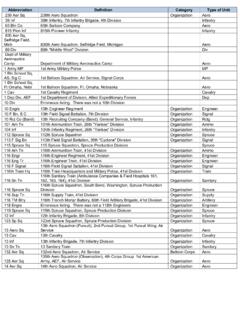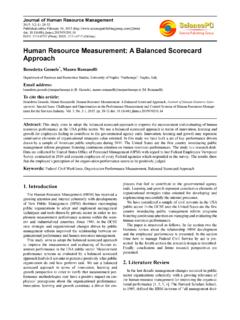Transcription of The BALANCED SCORECARD
1 1 1999 The BALANCED SCORECARD Collaborative and Robert S. Kaplan. All rights S. KaplanHarvard Business SchoolTheBALANCEDSCORECARD2 1999 The BALANCED SCORECARD Collaborative and Robert S. Kaplan. All rights Is a BALANCED SCORECARD ?A Measurement A Measurement System?System?A Management A Management System?System?A Management A Management Philosophy?Philosophy?3 1999 The BALANCED SCORECARD Collaborative and Robert S. Kaplan. All rights Vision and Strategy: Four PerspectivesVision andStrategyObjectivesMeasuresTargetsInit iativesFINANCIAL To succeed financially, how should we appear to our shareholders? ObjectivesMeasuresTargetsInitiativesLEAR NING AND GROWTH To achieve our vision, how will we sustain our ability to change and improve?
2 ObjectivesMeasuresTargetsInitiativesCUST OMER To achieve our vision, how should we appear to our customers? ObjectivesMeasuresTargetsInitiativesINTE RNAL BUSINESS PROCESS To satisfy our shareholders and customers, what business processes must we excel at? 4 1999 The BALANCED SCORECARD Collaborative and Robert S. Kaplan. All rights BALANCED SCORECARD Focuses on Factors that Create Long-Term Value Traditional financial reports look backward Reflect only the past: spending incurred and revenues earned Do not measure creation or destruction of future economic value The BALANCED SCORECARD identifies the factors that create long-term economic value in an organization, for example: Customer Focus: satisfy, retain and acquire customers in targeted segments Business Processes.
3 Deliver the value proposition to targeted customers innovative products and services high-quality, flexible, and responsive operating processes excellent post-sales support Organizational Learning & Growth: develop skilled, motivated employees; provide access to strategic information align individuals and teams to business unit objectivesProcessesCustomersPeople5 1999 The BALANCED SCORECARD Collaborative and Robert S. Kaplan. All rights Four Perspectives Apply to Mission Driven As Well As Profit Driven Organizations What must we do to satisfy our financial contributors? What are our fiscal obligations?
4 Whois our customer? What do our customers expect from us? What internal processesmust we excel at to satisfy our fiscal obligations, our customers and the requirements of our mission? How must our people learn and develop skills to respondto these and future challenges?Profit DrivenProfit DrivenMission DrivenMission Driven What must we do to satisfy our shareholders? What do our customersexpect from us? What internal processesmust we excel at to satisfy our shareholder and customer? How must our people learn and develop skills to respondto these and future challenges?Financial PerspectiveCustomer PerspectiveInternal PerspectiveLearning & Growth PerspectiveAnswering these questions is the first step to develop a BALANCED Scorecard6 1999 The BALANCED SCORECARD Collaborative and Robert S.
5 Kaplan. All rights BALANCED SCORECARD Framework Is Readily Adapted to Non-Profit and Government OrganizationsThe Mission, rather than the financial / shareholder objectives, drives the organization s strategy"If we succeed, how will we look to our financialdonors? To achieve our vision, how must our people learn, communicate, and worktogether? To achieve our vision, how must our people learn, communicate, and worktogether? The Mission To satisfy our customers, financial donors and mission, what business processesmust we excel at?" To satisfy our customers, financial donors and mission, what business processesmust we excel at?
6 " To achieve our vision, how must we look to our customers? 7 1999 The BALANCED SCORECARD Collaborative and Robert S. Kaplan. All rights PerspectiveFinancial Accountability PerspectiveInternal Process PerspectiveLearning and Growth PerspectiveReduce CrimeReduce CrimeIncrease Perception of SafetyIncrease Perception of SafetyAvailability of Safe, ConvenientTransportationAvailability of Safe, ConvenientTransportationMaintain CompetitiveTax RatesMaintain CompetitiveTax RatesImprove Service QualityImprove Service QualityPromote Economic OpportunityPromote Economic OpportunityStrengthen NeighborhoodsStrengthen NeighborhoodsEnhance Knowledge Management CapabilitiesEnhance Knowledge Management CapabilitiesClose Skills GapClose Skills GapAchieve PositiveEmployee ClimateAchieve PositiveEmployee ClimateStreamlineCustomer InteractionsStreamlineCustomer InteractionsImprove ProductivityImprove ProductivityIncreasePositiveContactsIncr easePositiveContactsSecure Funding/ServicePartnersSecure
7 Funding/ServicePartnersExpandNon-CityFun dingExpandNon-CityFundingMaximizeBenefit /CostMaximizeBenefit/CostGrow Tax BaseGrow Tax BaseMaintain AAA RatingMaintain AAA RatingPromote Community Based Problem SolvingPromote Community Based Problem SolvingThe City of Charlotte Corporate-level Linkage ModelIncrease InfrastructureCapacityIncrease InfrastructureCapacityPromote Business MixPromote Business Mix8 1999 The BALANCED SCORECARD Collaborative and Robert S. Kaplan. All rights are Companies Adopting a BALANCED SCORECARD ? ChangeFormulate and communicate a new strategy for a more competitive environment GrowthIncrease revenues, not just cut costs and enhance productivity ImplementFrom the 10 to the 10,000.
8 Every employee implements the new growth strategy in their day-to-day operationsThe Revenue Gr o wth Strateg y Improve stability by broaden i ng the sour c es of r evenu e fr o m current customer s The Prod uctivit y Strat eg y I mprove operating effici ency by shifti ng cust omers to mor e cost-effecti ve c hannel s of di st r i buti on Im pr o ve ReturnsIm pr o ve Operating Efficienc yBr oaden R e venue Mi xIncr ease Customer C onfi denc e i n Our Fi nanci al Ad viceIncr easeCustomer Satisfactio n Thr oug h Super i or Executi onIncreaseEm pl o yee Pr oducti vi t yAccess to Str ateg ic Infor matio nDevelop Str ateg ic Ski llsAlign Per sonal GoalsFinancialPerspect i veCustomerPerspect i veInternalPerspect i veLearning Perspect i veCross-Sel l the Pr o duct Li neShift to Appr opr i at e C hannelPr o vide R api d R esponseDe vel op New Pr oductsMini mize Pr oble msU nder stan d Customer Seg ments9 1999 The BALANCED SCORECARD Collaborative and Robert S.
9 Kaplan. All rights Do We Need a BALANCED SCORECARD ? To Implement Business Strategy! Less than 10% of strategies effectively formulated are effectively executed Fortune Business Strategy is now the single most important and will remain so for the next five years Business Week10 1999 The BALANCED SCORECARD Collaborative and Robert S. Kaplan. All rights Research Has Identified Four Barriers to Strategic ImplementationToday s Management Systems Were Designed to Meet The Needs of Stable Industrial Organizations That We re Changing IncrementallyYou Can t Manage Strategy With a System Designed for TacticsOnly 5% of the work force understands the strategy60% of organizations don t link budgets to strategyOnly 25% of managers have incentives linked to strategy85% of executive teams spend less than one hour per month discussing strategy9 of 10 companies fail to execute strategyThe People BarrierThe Vision BarrierThe Management BarrierThe Resource
10 Barrier11 1999 The BALANCED SCORECARD Collaborative and Robert S. Kaplan. All rights SCORECARD Early Adaptors Have Executed Their Strategies Reliably and Rapidly(USM&R)1993#6 in profitability199519961997#1 in profitability#1 in profitability#1 in profitabilityMobil1993 Property & CasualtyRetail Bank1993 Profits = $x199419951996 Profits = $8xProfits = $13xProfits = $19xBrown & Root Engineering (Rockwater)1993 Losing money1996#1 in growth and profitabilityProfitStock$275M lossStock Price = $591994199519961997$15M$60M$80M$98M$74$1 14$146$20512 1999 The BALANCED SCORECARD Collaborative and Robert S. Kaplan. All rights BSC Early Adaptors Have Executed Their Strategies Reliably and RapidlyThe Solution Was Already ThereBeat the Odds9 of 10 companies fail to execute their strategiesFast2 to 3 years to achieve breakthrough results The BSC helped create focus and alignment to unlock the organization s hidden assets 13 1999 The BALANCED SCORECARD Collaborative and Robert S.











